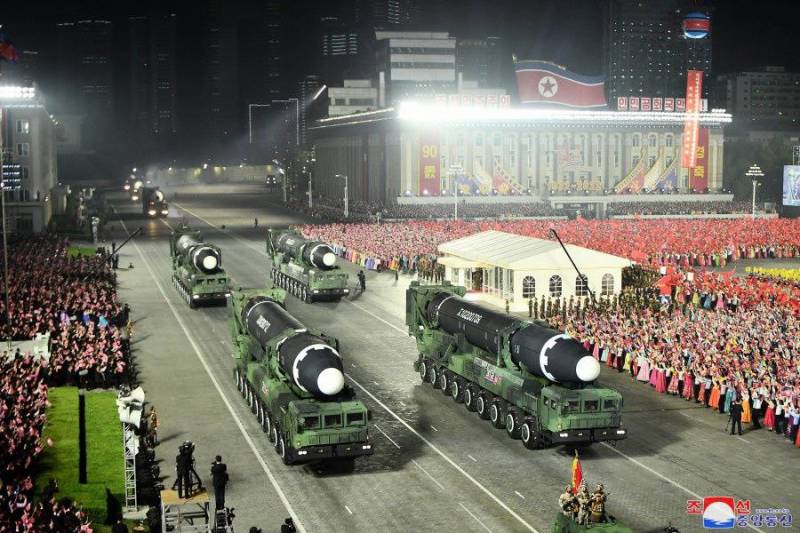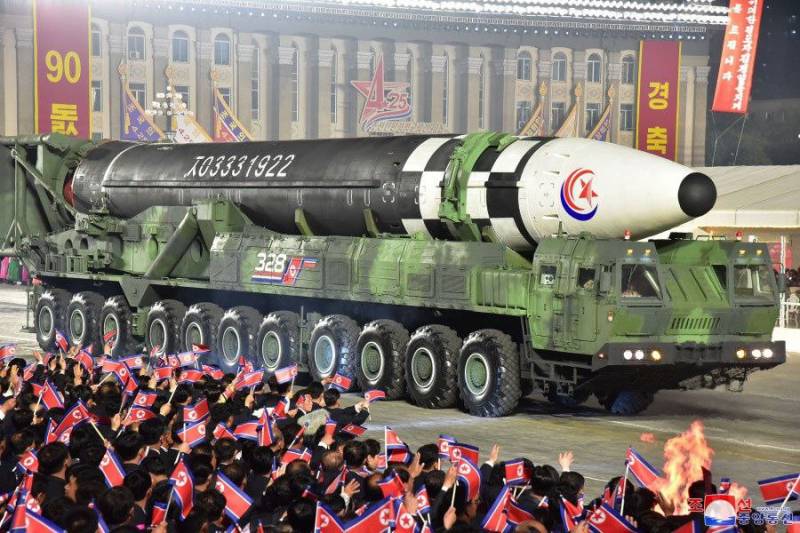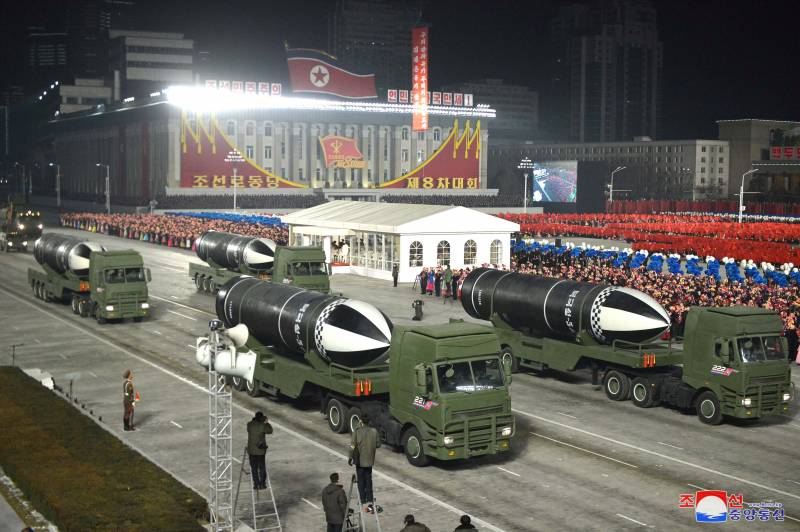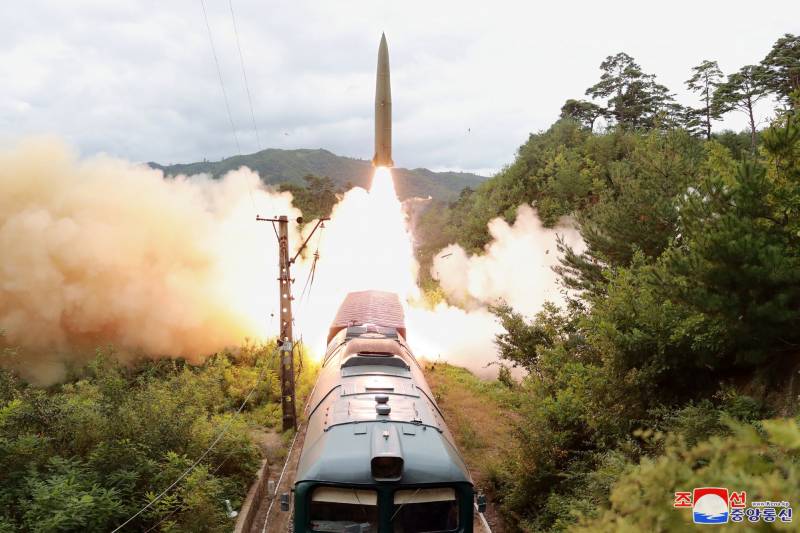Official Warning: DPRK Nuclear Policy Law

ICBM "Hwaseong-15" at one of the last parades
On September 8, the DPRK leadership officially published the new Law on Policy on Nuclear Armed Forces. This document defines the role and mission of nuclear weapons in the country's strategic security, their goals and objectives in a conflict, as well as the principles and conditions for combat use. The publication of the law is aimed at informing third countries, incl. potential adversaries, and providing effective strategic deterrence.
Key provisions
The new law notes that the nuclear armed forces (NAF) are a powerful means of protecting the sovereignty, territorial integrity and interests of the DPRK. They must prevent war both on the Korean Peninsula and throughout Northeast Asia. It is also reported that the DPRK has reliable, effective and ready-to-use nuclear deterrence forces. They are ready to solve the assigned tasks in accordance with the adopted policy.
The goals of the publication of a new law on policy regarding nuclear forces are named. This move should prevent misjudgment between nuclear powers and the misuse of nuclear weapons. As a result, the risks of starting a nuclear war should be reduced.
The new law includes 11 clauses that define certain aspects of the policy in the field of nuclear weapons. The mission of the nuclear forces, their composition, the principles of command and control, as well as the implementation of decisions made, the principles and conditions for the use of nuclear weapons, issues of mobilization, permanent service and further development of nuclear weapons, as well as non-proliferation measures and measures of an organizational and legislative nature are consistently described.
For obvious reasons, the law dispenses with unnecessary details. Thus, paragraph 1 describes the mission of nuclear forces in the form of deterrence by creating a threat or inflicting defeat, but does not specify the exact strategies and tactics for using nuclear weapons. The composition of the YaVS is also described extremely vaguely: the corresponding paragraph only lists the presence of weapons, delivery vehicles, command systems, etc.

Promising missile "Hwaseong-17"
Paragraph 3 of the law indicates that the NAF is directly subordinate to the unified command of the Chairman of State Affairs of the DPRK, and he is authorized to resolve all relevant issues. At the same time, there are governing bodies designed to assist the Chairman in carrying out all activities.
In the event of a threat to the control loops, nuclear forces must immediately carry out a strike according to a pre-drawn and approved plan. In accordance with clause 4, orders for the use of nuclear weapons from the command are also carried out immediately.
Points 7 and 8 define the permanent mobilization of nuclear forces. At the same time, the conditions for the safe storage and operation of special combat units are determined. Item 9 calls for the strengthening and development of the YaVS. In addition, he determines the need for periodic updating of the nuclear doctrine in order to maintain its relevance.
Principles and conditions of application
Of particular interest is paragraph 5 of the law - "Principles of the use of nuclear weapons." In accordance with it, the DPRK intends to use nuclear warheads as the last response to external aggression, which poses a serious threat to the state and people. At the same time, the DPRK does not threaten its own nuclear weapons and does not use them against non-nuclear countries. However, only as long as they do not participate in aggression together with the nuclear powers.
Clause 6 introduces five conditions for the use of nuclear weapons against an aggressor. The reasons for this are the committed or expected attack using nuclear weapons or other weapons of mass destruction or non-nuclear weapons, aimed at the country as a whole, its leadership, command structures or strategically important objects.

Promising missile for submarines "Pukkykson-5A"
In addition, nuclear warfare can be used to prevent the prolongation of an armed conflict. Nuclear weapons will also be a response to other circumstances associated with a catastrophic risk for the continued existence of the country and people.
Real Opportunities
In the context of the new law, it is mentioned that the DPRK already has a full-fledged nuclear force, showing the required efficiency and reliability. At the same time, the composition and capabilities of such nuclear warheads, for obvious reasons, are not specified. However, there is various information about the processes of development of these forces and their possible results.
Recall that the DPRK conducted the first test explosion of a nuclear charge in 2006. In 2017, the first tests of a thermonuclear weapon took place. To date, several nuclear tests have been carried out, which shows the ability of the industry to manufacture, at a minimum, single warheads. However, there are also bolder assessments.
Various foreign sources report that the DPRK was able to establish the production of weapons-grade plutonium. Several tens of kilograms of this raw material are produced annually, which is enough to produce 10-12 ammunition with a capacity of tens of kilotons. Such charges can be used as part of combat units for existing and future missiles. By now, the YaVS could receive at least several dozen warheads.
The DPRK army has a wide range of missile systems for various purposes. It is armed with operational-tactical systems, short and medium-range missiles. In recent years, a number of new intercontinental missiles have been developed. In addition, work continues on the subject of submarine missiles. Most of the existing or being created missile systems can use both conventional and special warheads. How difficult it is to replace combat equipment is unknown.

Operational-tactical missile system in the railway version
Apparently, the current plans of the command provide for the use of nuclear warheads on the IRBM or ICBM. Due to the high flight characteristics, such delivery vehicles should ensure the maximum effect from the use of nuclear weapons.
So, by now, the Hwaseong-14 and Hwaseong-15 ICBMs, the range of which can reach 10-12 thousand km, could have entered service. This year, tests of the Hwaseong-17 complex took place with an estimated range of at least 13 thousand km. SLBMs of the Pukkykson series so far fly only 2-2,5 thousand km, however, the underwater platform seriously increases the overall range of the entire complex.
How many missiles and warheads on them can be equipped with nuclear warheads is unknown. At the same time, the nuclear forces of the DPRK already have the ability to deliver such a load to targets on another continent. ICBMs of the latest models make it possible to attack targets almost throughout Europe and the United States. The effectiveness of such a strike depends on its quantitative indicators, the configuration of the combat load and the effectiveness of the potential enemy's missile defense system.
The DPRK, apparently, does not yet have the possibility of a massive strike capable of overloading the missile defense systems of third countries. However, nuclear weapons raise the stakes significantly: even one missed warhead will cause serious damage to infrastructure, inflict casualties on the population, and also hurt public sentiment. Accordingly, even in the current configuration, the DPRK's nuclear forces are capable of solving the tasks of strategic deterrence, albeit with some restrictions.
Official warning
Thus, to date, the DPRK has been able to create its own nuclear weapon and a range of delivery vehicles for it. The nuclear missile potential of the army is gradually growing - along with the ability to deter a potential enemy, and, if necessary, to strike back.
At the same time, at the current stage of development of the NAF, effective deterrence requires measures not only of a military-technical nature. The enemy must know and understand what awaits him in the event of aggression. It is for this purpose that the DPRK has not only passed a new law on nuclear force policy, but also publicly published it. Whether such a signal will be understood by its addressees in the person of third countries is unknown. But Pyongyang has made its position clear and has shown its readiness to continue its current policy.
Information